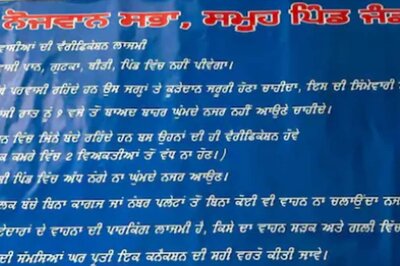
views
Covid-19 pandemic has changed our lives in many ways and one of them is the way we watch films. OTT platforms are the new cinema halls for movie goers… we meant movies watchers – you don’t need to go anywhere now to watch films, other than from one room to another in your homes.
As your watching experience has evolved, so has the content. The Manoj Bajpayees, Ayushmann Khurranas and Pankaj Tripathis of Bollywood have replaced the Khans – Salman, Shah Rukh and Aamir. There are more films with actresses as protagonists, but the A-listers have stayed away so far.
Films have become shorter, and some are just a collection of short films put together – an anthology. Web series trend, and are hot favourites. Potboilers and mass entertainers have made way for subtle, more meaningful cinema. Not to worry, the former films are there too.
In this series, OTT Trends, News18 looks at how streaming platforms have redefined Indian cinema, blurred lines between mainstream and indie, cut across language barriers, made actors into stars, and above all, brought entertainment at your fingertips.
Streaming services, by virtue of being available over the internet, are not bound by geography. Within India, lines between regional and national content is fast disappearing as content in various languages land on the same streaming platforms. At the same time, films and web series from various other regions of the world, not necessarily in English, have become more accessible.
One brilliant example is the film 365 Days on Netflix, that became an overnight sensation, making Michelle Morrone an international star in no time. The Polish production had an Italian protagonist and is one of the most watched items in numerous territories on multiple continents. Similarly, Fahadh Faasil’s Malayalam film Malik and Arya starrer Tamil title Sarpatta Parambarai are joining the thousands of TV shows and movies from Hollywood and Bollywood that are available in the Amazon Prime Video catalog. Such exchange of content on a single platform is unique to streaming services only.
While we see an increased collaboration between talents from various regions for successful projects, content consumption has gone beyond language and cultural limitations. Actor Swwapnil Joshi’s digital foray Samantar, a Marathi show, has entertained audiences from various communities since it was available on a pan-India platform like MX Player. The actor believes that there is nothing called ‘regional content’ anymore, as shows and films made in any language can be watched by anyone now.
He also points out that an international hit like Money Heist is also technically a regional show, since it’s made in Spanish, but consumed all over the world. “All over the world, the mantra is to go regional. That has been the key word in the last year or two, predominantly. Technically, Narcos and Money Heist are regional shows. In India, Hindi is the mainstream language, so that’s why a show made in that language is called a pan-India show.
“With OTT coming in, there is no division of content in terms of national or regional. It’s all boiling down to one word, one content kind of a scenario where it’s only about good content, or not so good content. So shows like Ek Thi Begum or Samantar are consumed beyond the language of inception – be it in Tamil, Telugu, Bengali and other languages even outside the country where they must have been dubbed. OTT has really broken the shield of linguistic barriers, and taken content to its rightful users, that if you like a particular genre of content, watch it,” Swwapnil told News18.
Actress Anuja Sathe, who has starred in multiple films and TV shows in Marathi, made her digital debut with Ek Thi Begum, a Hindi series on MX Player. “It was not treated as a regional or a national kind of show, because the format that we had was that every actor will speak in the mother tongue of their character. I think that was very organic. Some were Hindi-speaking characters and a few were outright Maharashtrian roles who spoke in Marathi. That sort of widened the horizon of this particular content. It was fun working with such a format. I played a Muslim character based in Bombay, so obviously, that girl would understand Marathi. But her own mother tongue would be Hindi or Urdu. But the other characters were Maharashtrian and they were speaking in Marathi. So it was a great combination and a mixture of all the languages that are spoken in Mumbai or Maharashtra overall,” Anuja said.
“There is so much diversity in our country, and a lot of people want to experience other cultures. And it’s great to explore other things as well. You know, I think we always had Marathi industry, Punjabi industry, Tamil industry – but I think they all are merging together (on OTT). And that’s a great thing, because then we are living that diversity,” she added.
Tamil superstar Arya is taking his very local story about clash of boxing clans in ’70s Chennai to a global audience through Amazon Prime Video next week. He says earlier streaming platforms were probably taken for granted, but have now become a great medium to reach a much wider audience. “We never explored this space as we are doing right now, maybe because we took it for granted before the pandemic. But the kind of launch your movie gets on a platform like Amazon, it is watched all across the globe on the same day of release. The next day you know how well it has been accepted across regions. There is no language barrier. That’s a huge opportunity and a huge space where there’s still lots more to explore,” he told News18 during a recent interaction.
Actor Rohit Saraf, who has starred in Netflix titles like Ludo and Mismatched, agrees that the Indian audience is now more accepting towards content from various regions and that the lines between national and international content is blurring. He told IANS, “I believe with newer platforms and channels bringing in content from across regions, the lines between national and international content is blurring. Also, our audience has evolved and so have their preferences. Now there is a movie/show for every kind of audience, which gives them more to experiment with and consume.”
Read all the Latest News, Breaking News and Coronavirus News here.
















Comments
0 comment